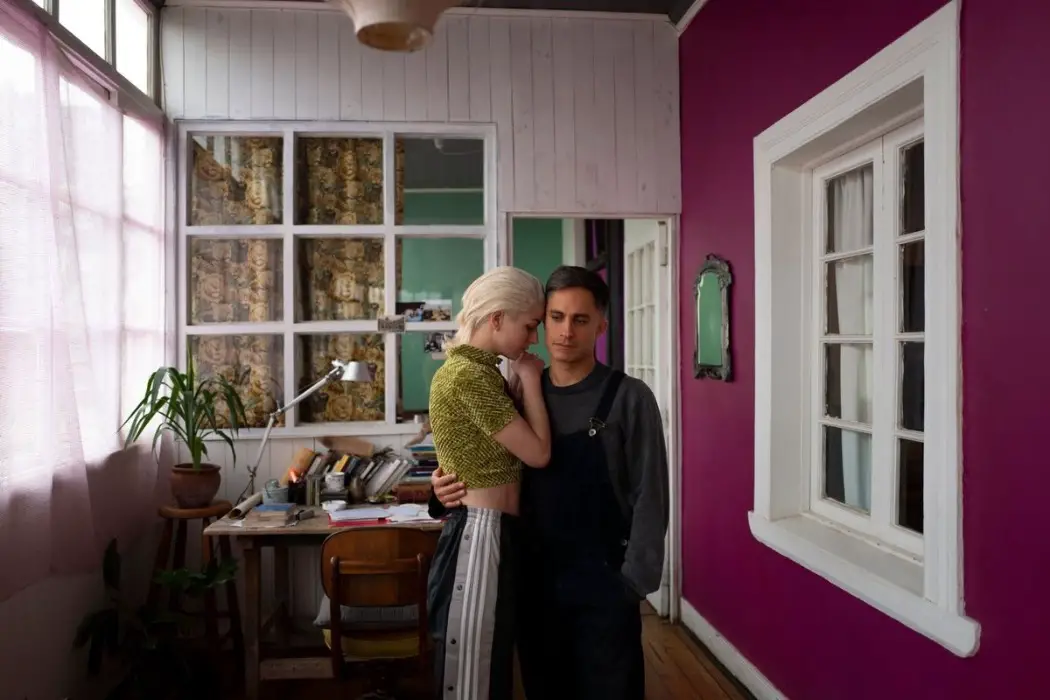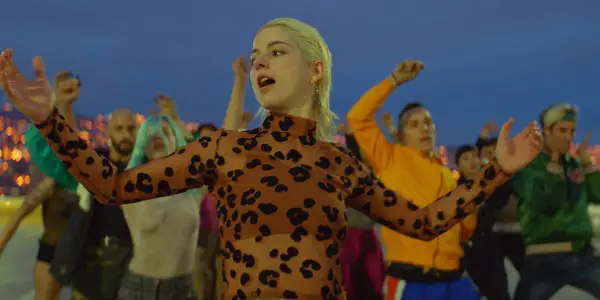EMA: Finding Liberation In Flame & Reggaeton Dance

Reyzando Nawara is a passionate film and TV enthusiast from…
People deal with loss in different ways, and there is no right or wrong when it comes to it. Some try to take it one day at a time while some others cope by openly expressing their feelings and devastation. For Ema (Mariana Di Girolamo), the titular character of Pablo Larraín’s euphoric Chilean drama, it is sex, street dance, flamethrower, and non-judgemental sisterhood that help her get through her loss. And Larraín captures every bit of Ema’s journey of regaining her inner strength in a way that defies any cinematic boxes. The result is a character study that is wild and intoxicating as much as it is empowering.
Marriage On The Verge Of A Nervous Breakdown
During the first 15 minutes of the movie, Larraín does not give us any clear context on what’s about to unfold. But in between a wild dance number featuring Ema and her dancing troupe, Nicolas Jaar’s synth-pop score, and Sergio Armstrong’s mesmerizing neon-drenched visual, we get a glimpse into the conflict that’s been eating Ema and her husband Gastón (Gael García Bernal) from every direction; their adoptive son Polo (Cristián Suárez) gives them no choice but to send him back after he nearly killed Ema’s sister in a fire. We don’t know who gets the last say in making this decision, but it’s obvious that both Ema and Gastón are not handling it well.

People, be it from Gastón’s dance troupe or the school where Ema teaches, are judging them for giving up too easily when things get hard. But even without the outside stressors, there’s nothing on the inside that can save their marriage from drowning — it’s as if they’ve become just roommates at this point instead of husband and wife. When they’re together in the same room, there’s just no love or affection anymore. What’s left is just hate and hurtful words coming out of their mouths. Ema makes it clear and loud that she resents Gastón for his infertility. In Ema’s own words, her husband is like a “human condom”. Gastón, on the other hand, hates Ema’s for behaving inappropriately in front of Polo.
Throughout the movie, they keep arguing and blaming each other any way they can, and Larraín observes them in an intimate close-up. It’s through all of these arguments that Ema gets most of its sparks. And thanks to the hypnotic chemistry between Bernal and Girolamo, every tension buried deep inside of them is delivered excellently to the audience. Bernal, who’s been Larraín’s regular since 2012, is able to show the coldness Gastón feels toward Ema, but he does so while still displaying the regret and vulnerability that his character is feeling. He even gets to flex a bit of his comedic muscle when Gastón condescendingly makes a comment about Ema and her girlfriends’ penchant for dancing to reggaeton music, telling them that if they keep doing it, they might as well move to LA and take selfies there all the time.

With this portrait of a marriage on the verge of a nervous breakdown, Ema might risk being another feel-bad movie about the dissolution of a relationship. But Larraín’s, who’s been known as one of the most distinctive voices in the industry, successfully doubles down on what he’s been doing best throughout his career here — turning regular stories into something bolder and bigger. And in Ema’s case, it means telling the story in pure chaos, complete with a number of dance sequences and a series of random events as if all that happens in the movie is only happening inside Ema’s head. For some people, this style may prevent them to penetrate the characters’ emotions. But thanks to the charismatic leads and Larraín‘s laser focus exploration on the psyche of the characters, that’s not a problem at all. In fact, it is this style that makes Ema so captivating until the end.
This Girl Is On Fire
It is what happens in the second half of the movie, however, that makes Ema even more remarkable than what it already is. Naturally, there’s always a resolution to this kind of story. Either divorce or reconciliation, we can expect that the ending would give us some kind of closure. But that’s not the case here. Instead of just focusing on how Ema and Gastón’s loss affects their marriage, Larraín chooses to highlight Ema’s personal odyssey. And it’s not just her journey of dealing with the loss and pain she clearly suffers from, but also her journey of finding freedom and liberation, as well as rebuilding a new family unit in her own rules.
Fires are burning at every corner of the city nearly every night. And it comes from Ema and the flamethrower she’s got in her hand. Along with her friends, Ema also quits Gastón’s dance troupe and regularly starts dancing to reggaeton wherever they go despite what her husband says. At first, it looks like she just wants to piss Gastón off for always blaming her. But then it morphs into some kind of cathartic release, a way for her to cope with her loss and pain. When words aren’t helpful anymore, the best way to unwind is using your body, something that you know you have control of. As a dancer, Ema clearly understands this more than anyone. That’s why it shouldn’t be a surprise to see her also having sex with literally anything that moves throughout the movie. Because much like dance, sex is where you can express your feelings through physical movements.

As more sex and dance are happening throughout — and by the way, it happens a lot in a really artsy way — it’s getting more and more obvious that there’s something more behind what Ema’s doing. But Larraín smartly withholds the revelation until the final moment of the movie. And by the time you get to the end, this surprise element will change the way we perceive both the story and Ema. What begins as a character study of a woman dealing with her loss now evolves into a burning portrait of a woman finding her agency back and using every ounce of her muscle to get what she wants. Ema is, after all a mother. And what’s more motherly than a woman putting her maternal instinct on top of everything else?
Larraín’s depiction of his female lead is so refreshing. She’s allowed to be unapologetic and tough. But thanks to Girolamo’s electric performance, Ema is not just reduced as an agent of chaos or the female equivalent of Joker, but also as someone who is wholly human. Underneath her tenacious look, bleached-blonder hair, and leopard-print dress, Girolamo offers plenty of vulnerability to Ema, and it makes her deeply sympathetic. To think that she’s just a newcomer and already giving us this committed performance just makes it all the more remarkable.
A Fever Dream Cinema
Ema is not an easy movie to digest, and describing it in words wouldn’t do it justice. But believe me when I say this; Ema is not like any other film that has come out this year so far. Its celebration of female agency is like a fever dream — indescribable and euphoric, with captivating performances from Girolamo and Bernal at the center of it all, and Larraín’s subversive style burning our expectations throughout. You just have to experience it firsthand to understand what the hype is all about.
What do you think of the ending? Let us know in the comments!
Ema is available to stream on Mubi until 31st May.
Watch Ema
Does content like this matter to you?
Become a Member and support film journalism. Unlock access to all of Film Inquiry`s great articles. Join a community of like-minded readers who are passionate about cinema - get access to our private members Network, give back to independent filmmakers, and more.
Reyzando Nawara is a passionate film and TV enthusiast from Indonesia. When he's not watching TV and movies, he likes to cook and make sorbet.













